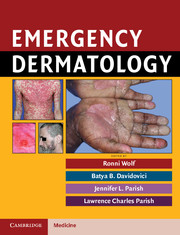Book contents
- Frontmatter
- Contents
- CONTRIBUTORS
- PREFACE
- Chap. 1 CELL INJURY AND CELL DEATH
- Chap. 2 CLEAN AND ASEPTIC TECHNIQUE AT THE BEDSIDE
- Chap. 3 NEW ANTIMICROBIALS
- Chap. 4 IMMUNOMODULATORS AND THE “BIOLOGICS” IN CUTANEOUS EMERGENCIES
- Chap. 5 CRITICAL CARE: STUFF YOU REALLY, REALLY NEED TO KNOW
- Chap. 6 ACUTE SKIN FAILURE: CONCEPT, CAUSES, CONSEQUENCES, AND CARE
- Chap. 7 CUTANEOUS SYMPTOMS AND NEONATAL EMERGENCIES
- Chap. 8 NECROTIZING SOFT-TISSUE INFECTIONS, INCLUDING NECROTIZING FASCIITIS
- Chap. 9 LIFE-THREATENING BACTERIAL SKIN INFECTIONS
- Chap. 10 BACTEREMIA, SEPSIS, SEPTIC SHOCK, AND TOXIC SHOCK SYNDROME
- Chap. 11 STAPHYLOCOCCAL SCALDED SKIN SYNDROME
- Chap. 12 LIFE-THREATENING CUTANEOUS VIRAL DISEASES
- Chap. 13 LIFE-THREATENING CUTANEOUS FUNGAL AND PARASITIC DISEASES
- Chap. 14 LIFE-THREATENING STINGS, BITES, AND MARINE ENVENOMATIONS
- Chap. 15 SEVERE, ACUTE ADVERSE CUTANEOUS DRUG REACTIONS I: STEVENS–JOHNSON SYNDROME AND TOXIC EPIDERMAL NECROLYSIS
- Chap. 16 SEVERE, ACUTE ADVERSE CUTANEOUS DRUG REACTIONS II: DRESS SYNDROME AND SERUM SICKNESS-LIKE REACTION
- Chap. 17 SEVERE, ACUTE COMPLICATIONS OF DERMATOLOGIC THERAPIES
- Chap. 18 SEVERE, ACUTE ALLERGIC AND IMMUNOLOGICAL REACTIONS I: URTICARIA, ANGIOEDEMA, MASTOCYTOSIS, AND ANAPHYLAXIS
- Chap. 19 SEVERE, ACUTE ALLERGIC AND IMMUNOLOGICAL REACTIONS II: OTHER HYPERSENSITIVITIES AND IMMUNE DEFECTS, INCLUDING HIV
- Chap. 20 GRAFT VERSUS HOST DISEASE
- Chap. 21 ERYTHRODERMA/EXFOLIATIVE DERMATITIS
- Chap. 22 ACUTE, SEVERE BULLOUS DERMATOSES
- Chap. 23 EMERGENCY MANAGEMENT OF PURPURA AND VASCULITIS, INCLUDING PURPURA FULMINANS
- Chap. 24 EMERGENCY MANAGEMENT OF CONNECTIVE TISSUE DISORDERS AND THEIR COMPLICATIONS
- Chap. 25 SKIN SIGNS OF SYSTEMIC INFECTIONS
- Chap. 26 SKIN SIGNS OF SYSTEMIC NEOPLASTIC DISEASES AND PARANEOPLASTIC CUTANEOUS SYNDROMES
- Chap. 27 BURN INJURY
- Chap. 28 EMERGENCY DERMATOSES OF THE ANORECTAL REGIONS
- Chap. 29 EMERGENCY MANAGEMENT OF SEXUALLY TRANSMITTED DISEASES AND OTHER GENITOURETHRAL DISORDERS
- Chap. 30 EMERGENCY MANAGEMENT OF ENVIRONMENTAL SKIN DISORDERS: HEAT, COLD, ULTRAVIOLET LIGHT INJURIES
- Chap. 31 ENDOCRINOLOGIC EMERGENCIES IN DERMATOLOGY
- Chap. 32 EMERGENCY MANAGEMENT OF SKIN TORTURE AND SELF-INFLICTED DERMATOSES
- Chap. 33 SKIN SIGNS OF POISONING
- Chap. 34 DISASTER PLANNING: MASS CASUALTY MANAGEMENT
- Chap. 35 CATASTROPHES IN COSMETIC PROCEDURES
- Chap. 36 LIFE-THREATENING DERMATOSES IN TRAVELERS
- Index
- References
Chap. 27 - BURN INJURY
Published online by Cambridge University Press: 07 September 2011
- Frontmatter
- Contents
- CONTRIBUTORS
- PREFACE
- Chap. 1 CELL INJURY AND CELL DEATH
- Chap. 2 CLEAN AND ASEPTIC TECHNIQUE AT THE BEDSIDE
- Chap. 3 NEW ANTIMICROBIALS
- Chap. 4 IMMUNOMODULATORS AND THE “BIOLOGICS” IN CUTANEOUS EMERGENCIES
- Chap. 5 CRITICAL CARE: STUFF YOU REALLY, REALLY NEED TO KNOW
- Chap. 6 ACUTE SKIN FAILURE: CONCEPT, CAUSES, CONSEQUENCES, AND CARE
- Chap. 7 CUTANEOUS SYMPTOMS AND NEONATAL EMERGENCIES
- Chap. 8 NECROTIZING SOFT-TISSUE INFECTIONS, INCLUDING NECROTIZING FASCIITIS
- Chap. 9 LIFE-THREATENING BACTERIAL SKIN INFECTIONS
- Chap. 10 BACTEREMIA, SEPSIS, SEPTIC SHOCK, AND TOXIC SHOCK SYNDROME
- Chap. 11 STAPHYLOCOCCAL SCALDED SKIN SYNDROME
- Chap. 12 LIFE-THREATENING CUTANEOUS VIRAL DISEASES
- Chap. 13 LIFE-THREATENING CUTANEOUS FUNGAL AND PARASITIC DISEASES
- Chap. 14 LIFE-THREATENING STINGS, BITES, AND MARINE ENVENOMATIONS
- Chap. 15 SEVERE, ACUTE ADVERSE CUTANEOUS DRUG REACTIONS I: STEVENS–JOHNSON SYNDROME AND TOXIC EPIDERMAL NECROLYSIS
- Chap. 16 SEVERE, ACUTE ADVERSE CUTANEOUS DRUG REACTIONS II: DRESS SYNDROME AND SERUM SICKNESS-LIKE REACTION
- Chap. 17 SEVERE, ACUTE COMPLICATIONS OF DERMATOLOGIC THERAPIES
- Chap. 18 SEVERE, ACUTE ALLERGIC AND IMMUNOLOGICAL REACTIONS I: URTICARIA, ANGIOEDEMA, MASTOCYTOSIS, AND ANAPHYLAXIS
- Chap. 19 SEVERE, ACUTE ALLERGIC AND IMMUNOLOGICAL REACTIONS II: OTHER HYPERSENSITIVITIES AND IMMUNE DEFECTS, INCLUDING HIV
- Chap. 20 GRAFT VERSUS HOST DISEASE
- Chap. 21 ERYTHRODERMA/EXFOLIATIVE DERMATITIS
- Chap. 22 ACUTE, SEVERE BULLOUS DERMATOSES
- Chap. 23 EMERGENCY MANAGEMENT OF PURPURA AND VASCULITIS, INCLUDING PURPURA FULMINANS
- Chap. 24 EMERGENCY MANAGEMENT OF CONNECTIVE TISSUE DISORDERS AND THEIR COMPLICATIONS
- Chap. 25 SKIN SIGNS OF SYSTEMIC INFECTIONS
- Chap. 26 SKIN SIGNS OF SYSTEMIC NEOPLASTIC DISEASES AND PARANEOPLASTIC CUTANEOUS SYNDROMES
- Chap. 27 BURN INJURY
- Chap. 28 EMERGENCY DERMATOSES OF THE ANORECTAL REGIONS
- Chap. 29 EMERGENCY MANAGEMENT OF SEXUALLY TRANSMITTED DISEASES AND OTHER GENITOURETHRAL DISORDERS
- Chap. 30 EMERGENCY MANAGEMENT OF ENVIRONMENTAL SKIN DISORDERS: HEAT, COLD, ULTRAVIOLET LIGHT INJURIES
- Chap. 31 ENDOCRINOLOGIC EMERGENCIES IN DERMATOLOGY
- Chap. 32 EMERGENCY MANAGEMENT OF SKIN TORTURE AND SELF-INFLICTED DERMATOSES
- Chap. 33 SKIN SIGNS OF POISONING
- Chap. 34 DISASTER PLANNING: MASS CASUALTY MANAGEMENT
- Chap. 35 CATASTROPHES IN COSMETIC PROCEDURES
- Chap. 36 LIFE-THREATENING DERMATOSES IN TRAVELERS
- Index
- References
Summary
ACUTE INJURY caused by burns produces some of the most horrendous and harrowing deformities encountered by persons working in the emergency and health care services. These injuries have a high mortality and, should the patients survive, they will carry with them the lifelong scars – physical, psychological, and emotional.
Worldwide, injury caused by fire is a major cause of morbidity, especially in sub-Saharan Africa where open fires are used to heat food and water. Sadly, most of these injuries occur in toddlers.
In the developed world, house fires and industrial accidents are the major culprits causing burn injury. In the United States alone, more than 500,000 people are seen in emergency departments each year as a result of burn injury; more than 50,000 are admitted to hospital, and more than 5000 deaths per year are attributed to the burn injury.
Approximately 50% of household and domestic burn injuries result from hot-water scalding and fires that occur in the kitchen. Most are managed outside hospital practice. Highest rates of burn-related injury and death are observed in children younger than 5 years and elderly persons older than 75 years. Since the introduction of gas-fired central heating and the tightening of health and safety laws, the incidence of these events has become less commonplace.
Heat energy is transmitted through radiation, conduction, and convection. Thermal injury usually occurs as a result of fire, but chemicals, electricity, and radiation can also cause burn injury.
- Type
- Chapter
- Information
- Emergency Dermatology , pp. 271 - 277Publisher: Cambridge University PressPrint publication year: 2011

